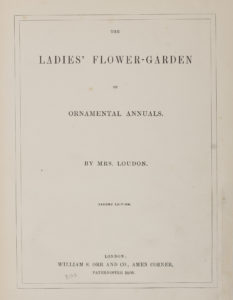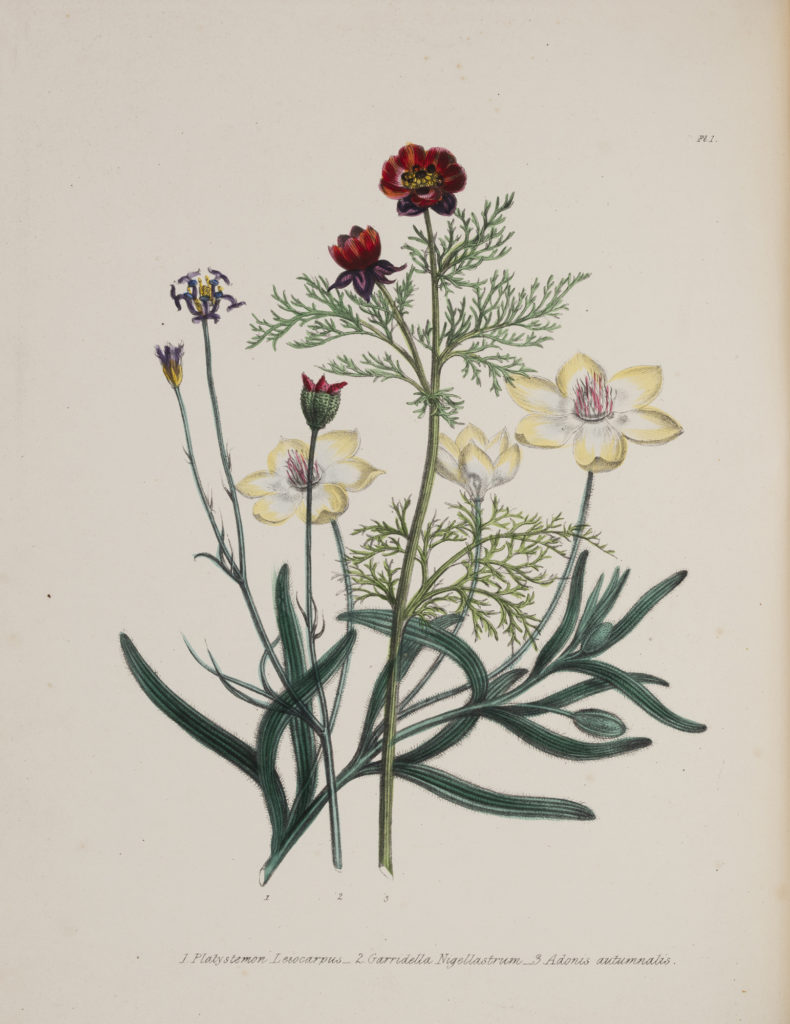Karissa Adams, a volunteer with the Library and Archives, writes:
Jane Webb Loudon was born in 1807 in Birmingham. In 1819, her mother died, prompting her bereft father to take Jane travelling around Europe; she was highly educated and during this trip she learned several languages and often read and sketched in her spare time. In 1824, when Jane was 17, her father died leaving her alone and dependent on herself for financial stability.
Jane realised that ‘it would be necessary for me to do something for my support’, so she turned to writing, anonymously publishing her first novel in three volumes called The Mummy!: A Tale of the Twenty-Second Century. Set in 2126, it is notable for its scientific inventions such as air-conditioners and coffee machines. The book received generally favourable reviews and attracted the attention of Scottish botanist John Claudius Loudon, who was so intrigued by the subject matter and scientific elements of the story, particularly a steam-driven plough, that he reviewed it in Gardener’s Magazine. Convinced that the author of such a book was a man, he arranged a meeting through a mutual acquaintance in 1830, with Jane recalling that:
It may be easily supposed that he was surprised to find the author of The Mummy a woman; but I believe that from that evening he formed an attachment to me, and, in fact, we were married on the 14th of the following September
Bea Howe (1961) Lady with green fingers, p.38.
Following their marriage, Jane immediately began to work in the garden alongside her husband, attending public lectures given by John Lindley and educating herself through her husband’s enormous botanical library. It was through these books that she realised how complicated the texts were for a novice such as herself .

In 1838 Jane published Young Ladies Book of Botany, followed by Gardening for Ladies (1840), The ladies’ flower-garden of ornamental annuals (1840) Botany for Ladies (1842), The Ladies Magazine of Gardening (1842), The Ladies Companion to the Flower Garden (1840–44) and My Own Garden (1855). In the introduction for Gardening for Ladies, Jane frequently mentions her ‘ignorance’ for knowing nothing about the subject and acknowledges her husband’s ‘instructions’ which allowed her to write the book. She goes on to state her reasons for doing so:
I think books intended for professional gardeners are seldom suitable to the wants of amateurs
Jane Loudon (1855) Gardening for ladies
Jane’s anecdotal style of writing and botanical illustrations provided her readers with accurate and easy to understand information and also allowed women to be physically active in their gardens in a manner which would have ordinarily been unsuitable. Gardening for Ladies contains an entire chapter dedicated to making hot-beds from manure and Jane writes about digging which, although ‘peculiarly unfitted to small and delicately formed hands and feet’, is ‘rendered comparatively easy’ when attention is paid to ‘the principles of mechanics and the laws of motion’. This allowed women to not only make their gardens look beautiful, but also partake and share in the science and technology offered during the Victorian era. Jane’s style of writing is encouraging as she often points out that certain tasks are laborious or difficult, but she clearly believes that her readers are perfectly capable of carrying them out.

Jane did not solely produce gardening advice books during her lifetime and her literary output went beyond her own publications and illustrations. Her husband John had lost the use of his right arm after a bone-setting operation went wrong, and his rheumatism cost him his left arm, so Jane became his ‘secretary’. She transcribed his Encyclopaedia of Cottage, Farm and Villa Architecture and summarised Lindley’s lectures for Gardener’s Magazine, though her contribution to this made her the target of vicious attacks of rival magazine editors, one of which referred to her as ‘the hag’ and ‘lying old woman’. The first edition of John’s Encyclopaedia of Cottage, Farm and Villa Architecture may not have been possible if it had not been for Jane frantically jotting down and editing his thoughts as he dictated them aloud, and she frequently promoted her husband’s publications within the introductions to her own books, even after his death. She helped transcribe and edit his magnum opus Arboretum et fruticetum Britannicum, which sought to document every tree and shrub in Britain, assisting him after the birth of their daughter Agnes and often staying up until two or three o’clock in the morning.
The Arboretum eventually bankrupted John and as his health declined Jane’s books provided some financial stability prior to his death in 1843. Even after his death, Jane released new editions of John’s work as well as seeing his last book, On the Laying Out, Planting and Managing of Cemeteries, through to publication. She was briefly the editor of a new magazine called The Ladies’ Companion: At Home and Abroad where she was responsible for the layout and served as a garden columnist, drama critic, and book reviewer whilst also attending operas, theatre performances, concerts, and flower shows. Reviews of the magazine were positive, with the Spectator describing it as ‘a handsome looking quarto journal’ and the Examiner stating that ‘it is printed and illustrated with much elegance and taste’. Other magazines at the time, such as Eliza Cook’s Journal and Home Circle were cheaper and had little to no illustrations, with the magazines focusing on needlework patterns, fashion, and home life, whereas Jane included news and current affairs, as well as commissioning professors to write articles on science and natural history.
She was sadly asked to resign from The Ladies’ Companion in 1848 and her book sales plummeted, leaving her virtually penniless before quietly passing away at the age of 51. However, the work she produced has been highly influential and her writing created a sense of understanding between herself and her readers in a way which had never been achieved before, giving them the freedom to do manual work for themselves and explaining how to complete tasks in a manner that was neither overly technical nor too vague. Through her own desire to learn and educate herself, she was able to share her experiences and knowledge with other women and her books created a new genre of horticultural guide book which was both scientifically accurate and easy to follow.
Further Reading:
Bilston, Sarah. ‘Queens of the Garden: Victorian Women Gardeners and the Rise of the Gardening Advice Text.’ Victorian Literature and Culture, vol. 36, no. 1, 2008, pp. 1-19.
Dewis, Sarah. The Loudons and the Gardening Press: A Victorian Cultural Industry. Ashgate Publishing Limited, 2014.
Horwood, Catherine. Gardening Women: Their Stories from 1600 to the Present. Virago Press, 2010.
Howe, Bea. Lady with Green Fingers: The Life of Jane Loudon. Country Life Limited, 1961.
Loudon, Jane. Gardening for Ladies. John Murray, 1843.
